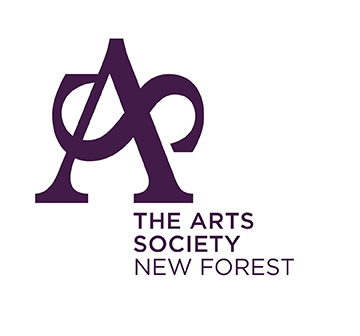As Good As Gold – a lecture by Alexandra Epps
This lecture was planned to be part of our celebration of the Golden Anniversary of the Society. Alexandra began by saying how gold shimmers and reflects light and stirs our emotions, how we have a timeless fascination for all things golden and how it appears eternal. She then began to take us on a very interesting and informative journey through ‘gold’ in art.
Alexandra began with images of Ancient Egypt. Moving onto early Christianity she explained how gold was used to represent the ‘immaterial’ as opposed to the material. 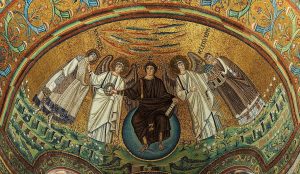 In Basilica San Vitali one of the masterpieces of the Byzantine we saw how golden tessare are used and set at an angle to catch and reflect the flicker of candlelight and bring the whole interior alive almost as a glimpse of heaven.
In Basilica San Vitali one of the masterpieces of the Byzantine we saw how golden tessare are used and set at an angle to catch and reflect the flicker of candlelight and bring the whole interior alive almost as a glimpse of heaven.
The Arena Chapel by Giotto (1305)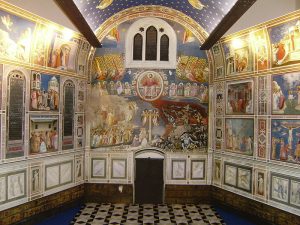 shows golden halos and the introduction of blue allows us to enter into the space of the painting and portrays more feeling and emotion. At this point in history blue is a more expensive pigment than gold and used to represent heaven. This is why we always see mary clothed in blue as the Queen of Heaven,
shows golden halos and the introduction of blue allows us to enter into the space of the painting and portrays more feeling and emotion. At this point in history blue is a more expensive pigment than gold and used to represent heaven. This is why we always see mary clothed in blue as the Queen of Heaven,
Looking at the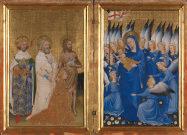 The Wilton Diptych (c1395) in the National Gallery which was created as a portable altarpiece for Richard II is like looking into a jewelled casket. It is a complicated mixture of the secular and religious symbolism. It shows Jesus giving the banner to King Richard thereby re enforcing the divine right of kings.
The Wilton Diptych (c1395) in the National Gallery which was created as a portable altarpiece for Richard II is like looking into a jewelled casket. It is a complicated mixture of the secular and religious symbolism. It shows Jesus giving the banner to King Richard thereby re enforcing the divine right of kings.
The San Pier Maggiore altarpiece by Jocopo di Cione (1370) and workshop 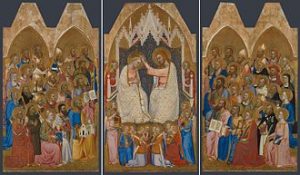 also in the National Gallery is the other end of the scale at originally 5metres in height. The middle tier representing ‘The Coronation of the Virgin’ showed many of the intricate gilding methods of the time.
also in the National Gallery is the other end of the scale at originally 5metres in height. The middle tier representing ‘The Coronation of the Virgin’ showed many of the intricate gilding methods of the time.
Fra Angelica’s ‘Annunciation’ altarpiece 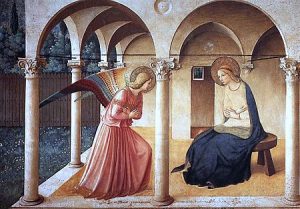 shows both interior and exterior with both Gabriel, Mary and the Garden of Eden. This is when Gothic meets the new language of the Renaissance. The golden burst in the corner shows the hands of God and contains a dove as the representation of the Holy Spirit. A work of great devotional beauty.
shows both interior and exterior with both Gabriel, Mary and the Garden of Eden. This is when Gothic meets the new language of the Renaissance. The golden burst in the corner shows the hands of God and contains a dove as the representation of the Holy Spirit. A work of great devotional beauty.
The Book of Hours of Louis XII (1498)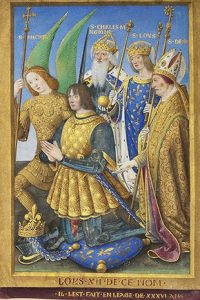 which would have been a a medieval best seller was an illustration of how finely gold details would have been used in manuscripts.
which would have been a a medieval best seller was an illustration of how finely gold details would have been used in manuscripts.
Madonna of the Magnificat by Botticelli (1481) 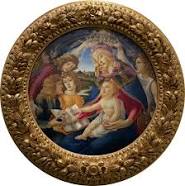 celebrates the writing of the Magnificat . In this circular painting covered in fine gold we see a golden crown lowered onto Mary’s head, rays of gold coming down from the crown and golden tones on the face. It was probably a commission as there is so much gold.
celebrates the writing of the Magnificat . In this circular painting covered in fine gold we see a golden crown lowered onto Mary’s head, rays of gold coming down from the crown and golden tones on the face. It was probably a commission as there is so much gold.
Also by Botticelli -‘The Birth of Venus we see again the entire canvas covered in fine golden highlights -so much gold – in the hair, in the eyes, in the flowers, the shell and in every detail. It is a symbol for the Renaissance itself as the rebirth.
 Titian’s painting of ‘Danae Receiving the Golden Rain’ (1650) shows darkness all around the cloud but Danae is suffused by gold as she is showered in the golden rain of Zeus
Titian’s painting of ‘Danae Receiving the Golden Rain’ (1650) shows darkness all around the cloud but Danae is suffused by gold as she is showered in the golden rain of Zeus
Gold also is shown as greed as in Matsy’s painting of the ‘Moneylender and His Wife’ 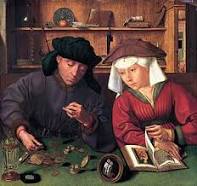 where the wife is clearly more interested in the gold her husband is counting than the scripture she is reading ! As in many Dutch paintings there are several hidden messages.
where the wife is clearly more interested in the gold her husband is counting than the scripture she is reading ! As in many Dutch paintings there are several hidden messages.
This connection between money and power is shown again in Vadim Zhakarov’s contemporary installation ‘Danae ‘
Klimt’s painting of ‘Danae’ 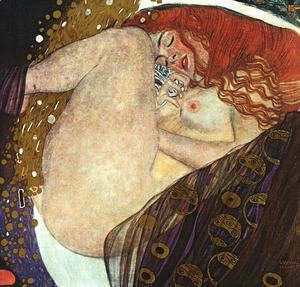 shows again the great power of gold. In the most famous painting of his golden phase Klimt’s ‘The Kiss’
shows again the great power of gold. In the most famous painting of his golden phase Klimt’s ‘The Kiss’ 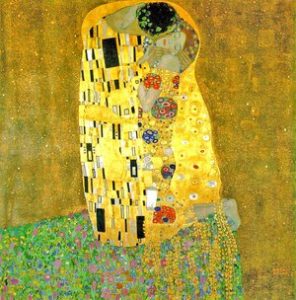 is so very golden. They almost make one shape and within their own halo. The shapes on the male side are hard whilst those on the female side are round and soft.In this painting Alexandra pointed out that Klimt has used at least 8 different types of gold.
is so very golden. They almost make one shape and within their own halo. The shapes on the male side are hard whilst those on the female side are round and soft.In this painting Alexandra pointed out that Klimt has used at least 8 different types of gold.
In Judith Holofernes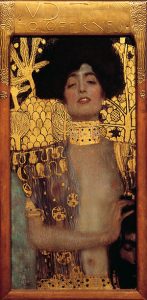 Klimt shows women being taken over by ornament. This was Klimt’s first painting in his golden phase and the model Adele Bloch-Bauer who also appears in his famous painting Adele Bloch Bauer – this was coined the Woman in Gold
Klimt shows women being taken over by ornament. This was Klimt’s first painting in his golden phase and the model Adele Bloch-Bauer who also appears in his famous painting Adele Bloch Bauer – this was coined the Woman in Gold 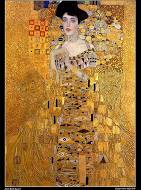 and is all about the shimmering properties of pattern and wealth.
and is all about the shimmering properties of pattern and wealth.
Japanese art was a great influence on the work of Klimt as well as on the artist Whistler and we saw how he created the Peacock Room to the designs he wanted in the home of Frederick Leyland and how he interpreted gold in his own atmospheric landscapes.
The importance of gold representing the power of royalty is best seen on the coronation portrait of Elizabeth I where everything is totally gold – the dress, the crown, the shoes etc. Again in ‘Queen Victoria Receiving the Sacrament at her Coronation’ 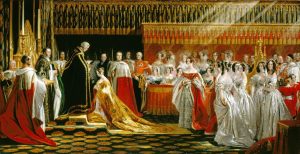 seen wearing the golden Imperial mantle and bathed in a shaft of golden light.
seen wearing the golden Imperial mantle and bathed in a shaft of golden light.
At the end of last century (1982) Roni Horn created ‘Gold Field’  more interested in the the physicality of gold she created a golden mat ‘a volumeless sculpture’ that inspired another artist – Felix Gonzalez Torres to create his own gold field out of 1000s of golden sweets representing ideas of life,love and transience. The audience is invited to take the sweets so they become part of the work.
more interested in the the physicality of gold she created a golden mat ‘a volumeless sculpture’ that inspired another artist – Felix Gonzalez Torres to create his own gold field out of 1000s of golden sweets representing ideas of life,love and transience. The audience is invited to take the sweets so they become part of the work.
Alexandra concluded with paintings of the gold of nature – Houses of Parliament ‘ by Monet  Autumn Gold by John Atkinson,
Autumn Gold by John Atkinson, and finally the huge installation by Olafur Eliasson -‘ The Weather Project’
and finally the huge installation by Olafur Eliasson -‘ The Weather Project’  where he created the sun and sky inside the Turbine Hall at Tate Modern which made viewers relate back to the awe of the ancients when seeing the sun rise and set.
where he created the sun and sky inside the Turbine Hall at Tate Modern which made viewers relate back to the awe of the ancients when seeing the sun rise and set.
